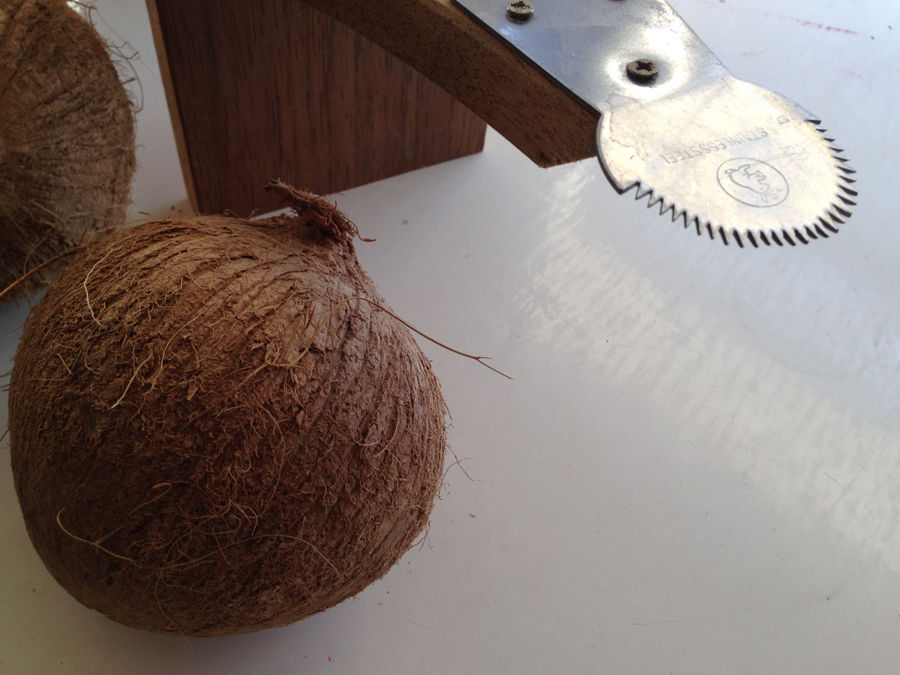It’s been years since I used a Thai “rabbit” grater. I brought mine out storage to grate fresh coconut for a sticky rice dessert that I prepared for a four-course Thai meal at Julian in March.
The grater is referred to as “rabbit” because the elaborate versions of the tool were once carved into that animal’s shape. Today, the wooden stool with a serrated blade extending from the neck is still referred to as a rabbit (gkra-dtai in Thai). A rabbit image is embossed on the thin blade.
The dessert uses steamed sticky rice topped with a blend of sweet corn, sugar, salt, coconut juice and shredded coconut meat. Preparation involves rinsing the rice repeatedly to remove excess starch before steaming. I use a woven basket filled with a quantity of rice that is suspended over a pot of boiling water for about 20-30 minutes until the rice is done. Sticky rice differs from long-grain jasmine rice because it is glutinous (glue-like and sticky, not gluten) when cooked. Other types of rice cannot be substituted for sticky rice and achieve the same result.
The other time-consuming dessert preparation involves shredding fresh coconut. Thai chef Kasma Loha-unchit writes in great detail about shredding coconut using a rabbit. Here’s a quick primer.
First, purchase coconuts that feel heavier than others. A heavy coconut contains more meat and juice inside. You should be able to shake the coconut and hear juice sloshing inside. The shell should have no obvious exterior cracks.
Before opening the coconut, set out a large bowl or pot. Take the back of a heavy chef’s knife or kitchen mallet. Hold the coconut in the palm of your weaker hand and whack the shell several times with the back of the knife (carefully!) or mallet until the shell cracks. Pry the shell open and let the juice drain out. Continue to pry the shell apart until it splits. Reserve the juice.
Whenever my Mom split coconut in this fashion, my sister, brothers and I vied for a taste of the fresh juice. That intense pure flavor reminds me of childhood and Thailand. It was always disappointing when a rare coconut yield sour juice, indicating it was spoiled. After tasting the juice, Mom usually enlisted us to grate the coconut on the rabbit.
The method involves sitting down on the stool with legs straddled on both sides. Using one or both hands, you push the coconut’s interior against the serrated blade to grate the meat. The shredded coconut is captured on a plate or tray below. Ideally, you develop a rhythm as you steadily grind the meat, rotating the shell and as blade works it way down. You don’t want to grind all the way to the shell’s interior or you’ll grate hard bits of the brown shell into the meat. If you’re paying attention, you’ll notice if brown specks show up on the plate. Whenever we thought we were done, Mom would inspect the shell and point out that there was more to grate. After one half was complete, we grated the other half of the shell. As kids, it seemed like it took forever.
When I cracked the shell, drained the juice and grated a pair of coconuts, the entire process only took about 20 minutes. Out of practice, I found myself picking out tiny bits of brown shell from the white shredded coconut.
To finish the dessert, I strained the juice to remove any unwanted strands of husk and shell. I added a little bit of juice to the steamed rice for flavor. Too much juice only makes the rice mushy. I sprinkled a mixture of cooked, cooled corn kernels, shredded coconut, salt, and sugar over the rice. The only step left is to grab a spoon and dig in.







